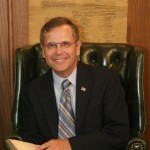 The latest tactic in Article V opponents’ game of “Whac-A-Mole”* is the circulation of an article 23 years out of date.
The latest tactic in Article V opponents’ game of “Whac-A-Mole”* is the circulation of an article 23 years out of date.
The article was published in 1992 and is entitled A New Constitutional Convention? Critical Look at Questions Answered, and Not Answered, by Article Five of the United States Constitution. It was authored by John Eidsmoe.
The article contains many of the inaccuracies about the amendments convention process that were common in 1992—such as the claim that the 1787 gathering was called by Congress, that it was called only to amend the Articles of Confederation, that the delegates exceeded their power, and that an Article V convention is a “ConCon.” All of those inaccuracies have been corrected in the ensuing years.
Unfortunately, the article includes other slips that should not have occurred even in 1992. One of these is the unusual assertion that when the Constitutional Convention added the amendment convention procedure, the delegates simply made a hasty mistake!
The article acknowledged that the delegates added the procedure on Sept. 15, 1787 “to guard against an unresponsive congress.” But it stated that “in contrast to the meticulous care the Framers exercised in deliberating on various other provisions of the Constitution, the Concon provision of Article V was added rather hastily, at a time when the delegates were preparing to close their deliberations; and this provision did not receive the careful attention given to most other provisions of the Constitution.”
In fact, however, the amendments convention procedure was not a new idea, but had been under consideration for weeks. It was based on provisions in several state constitutions and the delegates in Philadelphia had been discussing it well before anyone proposed the congressional method!
Thus the Constitution’s first draft, presented by the Committee of Detail on August 6, contemplated a convention of states as the sole mechanism for amendments:
“On the application of the Legislatures of two thirds of the States in the Union, for an amendment of this Constitution, the Legislature of the United States shall call a Convention for that purpose.”
Several delegates supported granting Congress direct power to propose as well, so the wording became:
The Legislature of the United States, whenever two thirds of both Houses shall deem necessary, or on the application of two thirds of the Legislatures of the several States, shall propose amendments to this Constitution . . . .
But this version had the unwitting effect of giving Congress sole power to propose. That went too far, and that is why George Mason successfully recommended re-inserting the convention of states as a proposal mechanism to bypass Congress.
The author speculated that the delegates’ supposed haste was why “there are many unanswered questions about the nature and effect of an Article V convention.” But the actual reason for the supposedly “unanswered questions” is simply because there was no need to go into detail: Americans had previously held many conventions among states and colonies, and were fully familiar with the procedures.
Now, it would be unfair to charge the author with findings about convention history that were made after 1992. However, the author should have known that the amendments convention procedure was vetted and discussed repeatedly during a ratification process that lasted nearly three years. Indeed, the procedure seems to have had an important role in securing public agreement to the Constitution.
For the history of publications about Article V, see Part I of my legal treatise, The Law of Article V.
* * * *
* Some constitutional scholars give the title “Whac-A-Mole” to convention opponents’ tactics of inventing new arguments after earlier arguments have been discredited. The later arguments are sometimes inconsistent with the former.
